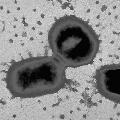



|
| This project is collaborated between The Forsyth Institute (TFI) and The Institute for Genomic Research (TIGR), and is funded by National Institute of Dental and Craniofacial Research (NIDCR) |
|
|
|||||||||||||||||||||||||
Random DNA sequencingTemplate preparation. Bacterial colonies containing plasmids from the random shotgun library are plated onto selective media directly from a library transformation. Use of fresh colonies is important for achieving high quality plasmid DNA sequencing templates. Automated cycle sequencing. The ABI Catalyst robot 800 is a sophisticated pipetting and temperature control robot that has been developed specifically for DNA sequencing reactions. Sequencing from small-insert, and lambda libraries will proceed in parallel. Approximately 35,200 good sequences of the small insert library are required to achieve 8x coverage. To achieve an 8x coverage with the Lambda clones ~ 1000 lambda clones will be prepared and sequenced from both ends. End sequences of these lambda clones will be used to define the position of each lambda on the genome map, thus provide a confirmation of the structure of the assembly. AssemblyAssembly of the genome sequence will be performed using TIGR Assembler (Sutton et al., 1995) which simultaneously clusters and assembles fragments of the genome using a best-match-first strategy. Potentially chimeric fragments and fragments representing the boundaries of repetitive regions are flagged based on partial mismatches at the ends of alignments and excluded from the contig. TIGR Assembler recognizes potentially repetitive regions (those present at more than one copy in the genome) based on 10-mer oligonucleotide frequency. Contig building in repetitive regions is more stringent than in non-repetitive regions to attempt to distinguish among closely related copies of the repeat element. TIGR Assembler is designed to accommodate clone size information coupled with sequencing from both ends of each template. This constraint demands that sequence fragments from two ends of the same template point toward one another in the assembly and are located within a certain number of base pairs (definable for each clone). TIGR Assembler can deal very well with repetitive elements that are either shorter than the average clone length in the library (generally 1.5-2.0 kbp) or are less than 97% identical. The accuracy of individual sequence fragments generated at TIGR is high; over 75% of the sequences generated in the M. jannaschii genome project have fewer than 1% ambiguous base calls. This permits rigorous assembly criteria to be used and reduces the impact of closely related repetitive elements.Assembly across the ribosomal RNA operons or other repeat areas (IS elements) that are longer than one kilobase may not be possible using TIGR Assembler if the operons or the repeat structures are >97% similar to each other. Each rRNA operon and repeat area will be sequenced independently by primer walking directly on the appropriate lambda DNA template |
||||
|
This page is created and maintained by Drs. Margaret Duncan, Floyd Dewhirst, and Tsute Chen, Department of Molecular Genetics, The Forsyth Institute . Last modified on 02/20/2002 Copyright 2000, 2001, 2002 by The Forsyth Institute |